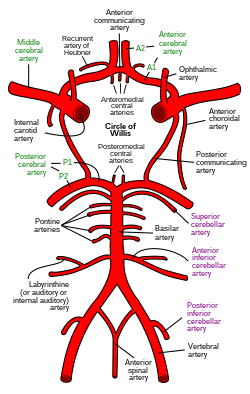The artery of Percheron (AOP) is a rare anatomical variation in the brain vascularization in which a single arterial trunk arises from the posterior cerebral artery (PCA) to supply both sides of the thalamus and midbrain.
| Artery of Percheron | |
|---|---|
 Diagram of the arterial circulation at the base of the brain (inferior view). The artery of Percheron (not shown) arise from either the left or right posterior cerebral artery (bottom forks) | |
 | |
| Details | |
| Source | Posterior cerebral artery |
| Supplies | Both sides of thalamus and midbrain |
| Anatomical terminology | |
Clinical significance
editThe functions of the thalamus and midbrain include the regulation of consciousness, sleep and alertness. Occlusion of the artery of Percheron, for example by a clot, could result in a posterior circulation infarct impairing structures on both sides of the brain. This can produce a bizarre disturbance such as sleep from which the patient cannot be awakened.[1]
History
editThe artery of Percheron was first described in 1973 by the French medical scientist Gerard Percheron.[2][3][4]
References
edit- ^ Sanders, Lisa (February 3, 2012). "Think Like a Doctor: Sleeping Wife Solved!". The New York Times.
- ^ Percheron G (August 1973). "The anatomy of the arterial supply of the human thalamus and its use for the interpretation of the thalamic vascular pathology". Zeitschrift für Neurologie. 205 (1): 1–13. doi:10.1007/BF00315956. PMID 4126735. S2CID 832292.
- ^ Agarwal N, Chaudhari A, Hansberry DR, Prestigiacomo CJ (January 2014). "Redefining thalamic vascularization vicariously through gerald percheron: a historical vignette". World Neurosurgery. 81 (1): 198–201. doi:10.1016/j.wneu.2013.01.030. PMID 23314026.
- ^ IV. The Parenchymal Blood Vessels of the Upper Brainstem, Its Nuclear Configuration and Vascular Supply (1976). The Upper Brainstem in the Human. Springer Berlin Heidelberg: Benno Schlesinger. pp. 175–238. ISBN 978-3-642-66257-7.